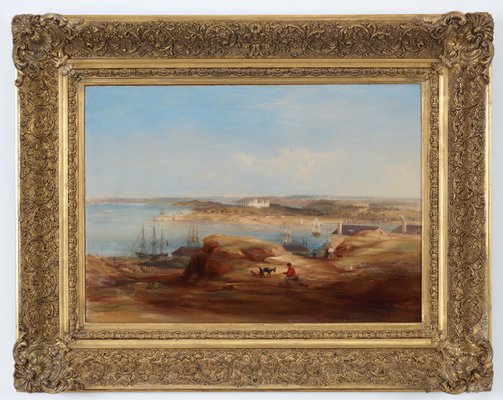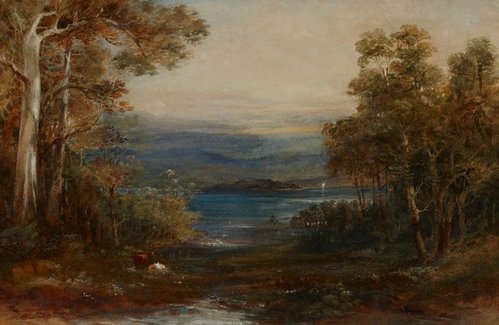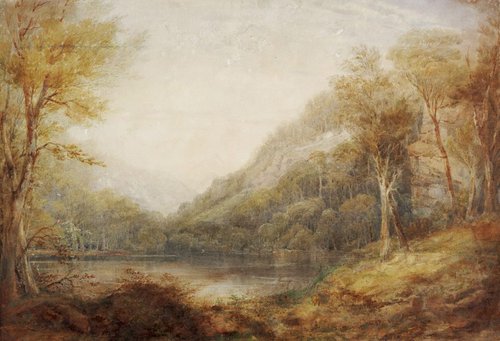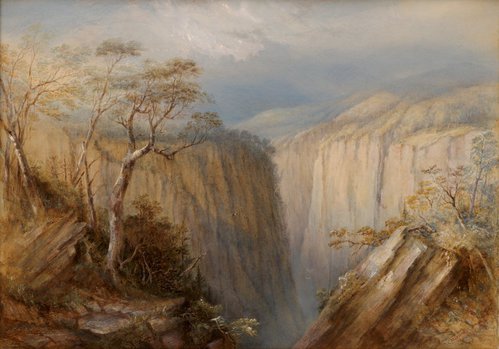Title
View of Sydney Cove
1848
Artist
-
Details
- Date
- 1848
- Media category
- Painting
- Materials used
- oil on canvas
- Dimensions
- 46.3 x 65.6 cm
- Signature & date
Signed and dated l.r. corner, oil "C. Martens 1848".
- Credit
- Gift of ANZ recognising the significant contribution David Gonski AC made to the bank as Chairman between 2014-2020
- Location
- South Building, ground level, Grand Courts
- Accession number
- 11.2021
- Copyright
- Artist information
-
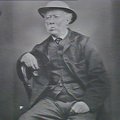 Conrad Martens
Conrad Martens
Works in the collection
- Share
-
-
About
Conrad Martens was born in London in 1801 and studied watercolour painting under Copley Fielding, the most popular landscape painter of his day who had also taught John Ruskin. In 1832 he accepted an offer of a voyage to India, but en-route in Montevideo, South America he joined the H M S Beagle as the ship’s artist, replacing the ailing Augustus Earle. He befriended the ships’ naturalist, Charles Darwin, whose empirical observations of landscape forms and climatic conditions would influence Martens’ practice.
Martens left the Beagle in Valparaiso, Chile, and travelled to Australia via New Zealand and Tahiti. He arrived in Sydney in June 1835 where he remained until his death in 1878. He was one of the only professional painters to settle permanently in Australia and make a living from his work during the first half of the 19th century.
In Sydney, Martens would become known as the first great painter of the harbour and surrounding waters. Through his engagement with the subject, Martens developed his own picturesque language of the harbour, making a vital contribution to the colonial aesthetics of the nascent city. He had a painting studio in Pitt Street where he offered lessons and lived in Cumberland Street in what is now the Rocks, thus living and working within the vicinity of harbour views.
View of Sydney Cove 1848 is a striking painting in Martens’ oeuvre. In this scene from Bunker’s Hill, of what is now the Rocks where Martens lived, the artist paints a view inspired by the vista from his window. It features the fledging town, but celebrates the inspiring water views, and the radiance of harbour light.
Martens considered there to be ‘no higher authority in landscape painting’ than Claude Lorrain and JMW Turner, and he here transcribes these influences onto this Sydney setting. While void of Turner’s turbulent atmospherics, Martens’ is conditioned by the London painter’s attention to the sensations of light which he here applies in shifts from soft shadow to light in the foreground and in the glowing, radiating vista across the water. Martens’ drew from Claude the notion of the Arcadian landscape, depicting the pre-industrial town with an overarching sunlit calm, nestled within a setting of exuding a serene order, despite the port’s activities. The Claude-like detailing of the red-shirted goat ‘shepherd’ in the foreground enforces the popular pastoral trope by which Martens paints the view of Sydney
.
An image of poetic tranquillity and romantic beauty, Martens envisages a scene that symbolically reinforces notions of colonial law and prosperity. The newly built Government House emerges as a luminous beacon in the landscape to visually encode these unceded Gadigal lands and waters as gleaming subjects of British rule.View of Sydney Cove is an overtly coded statement of the colony but also it resonates with the sensuous experiences of the landscape. The popularity of Martens’ harbour subjects, the mainstay of his artistic career, were in his inspired response to the stimulus of local light, land and water, which were delivered in paintings that suggest the deeper human histories of place.
-
Exhibition history
Shown in 2 exhibitions
An Australian view: art from the ANZ collection, Art Gallery of Ballarat, Ballarat, 02 Dec 2005–05 Feb 2006
An Australian view: art from the ANZ collection, Newcastle Art Gallery, Newcastle, 03 Mar 2006–30 Apr 2006
Grand Courts collection rehang, Art Gallery of New South Wales, Sydney, Nov 2021–2023
-
Bibliography
Referenced in 2 publications
-
Frances Lindsay, ANZ Art Collection, Melbourne, 1988, 10 (illus.).
-
John McPhee, An Australian view: art from the ANZ collection, 2005, n.p (colour illus.).
-

